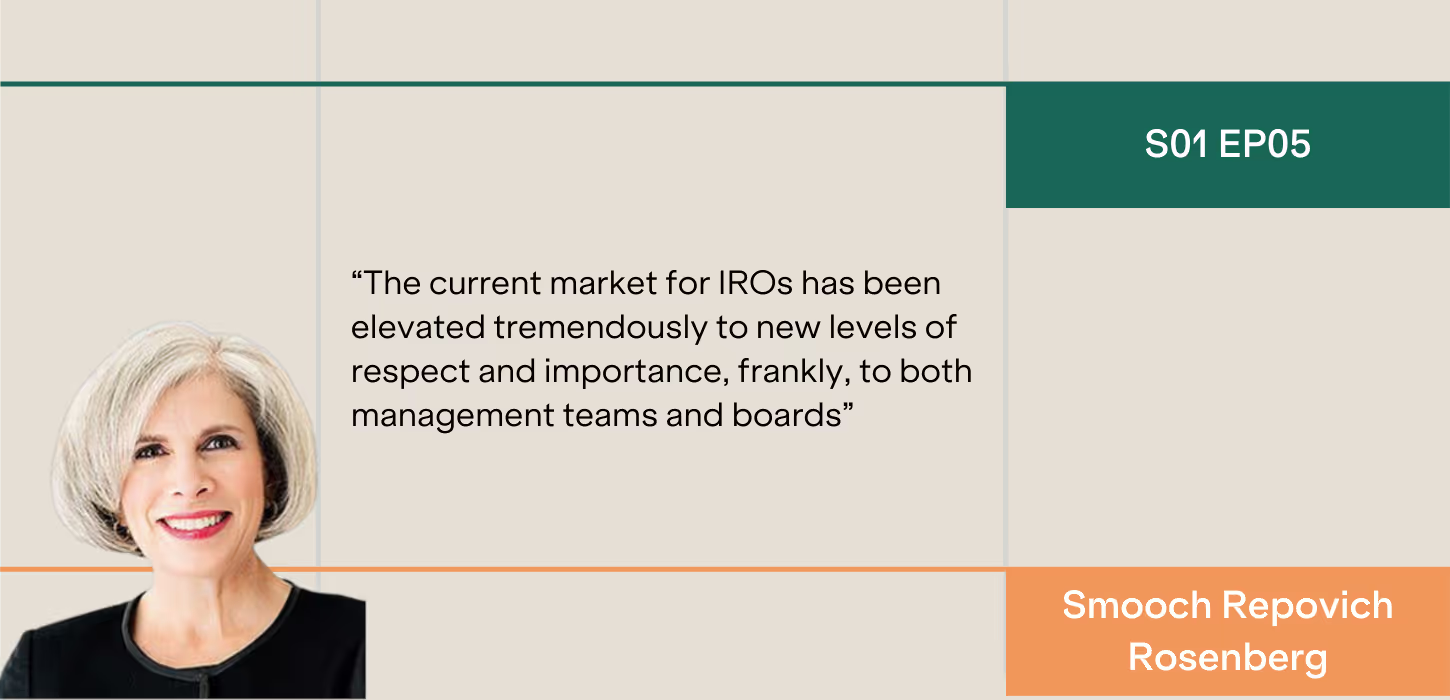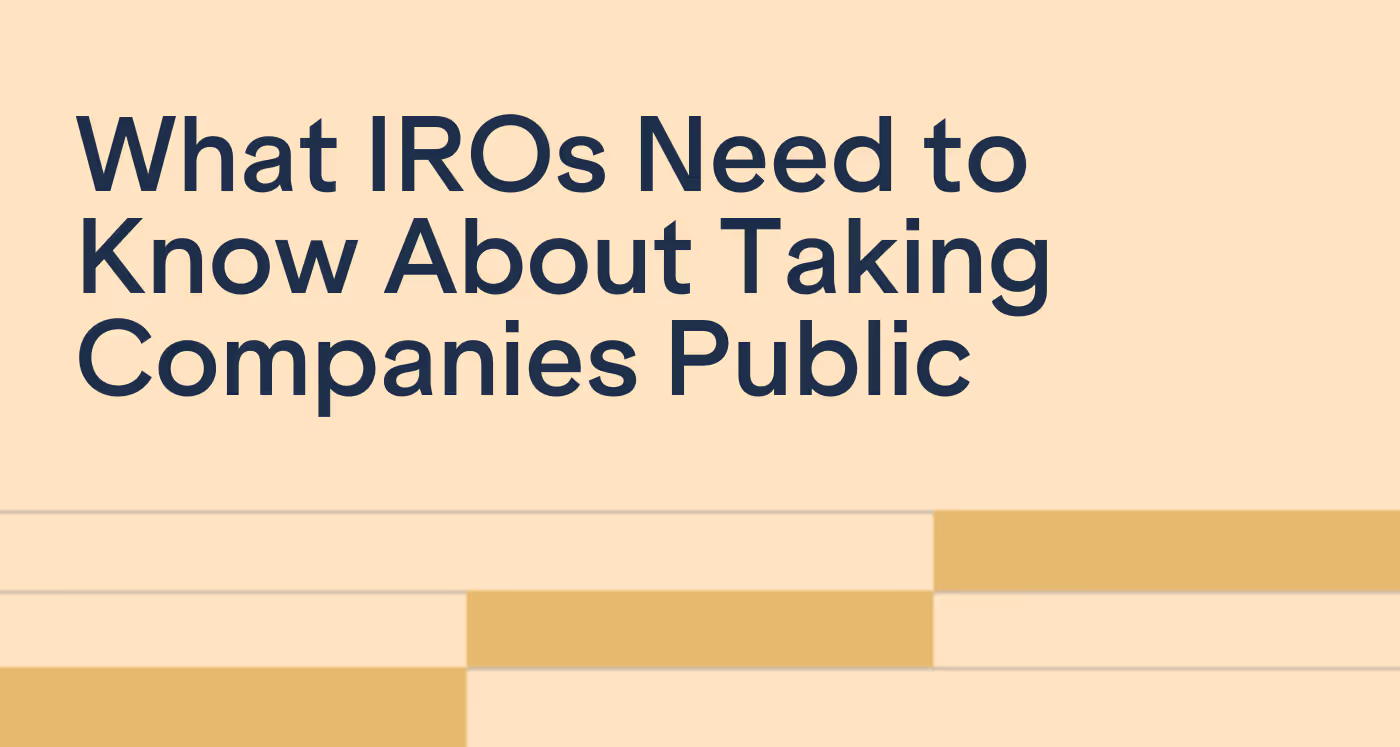
How to Build Effective Investor Targeting and Outreach Strategies for Small-Mid-Cap Companies
Learn how seasoned IR veterans are executing targeting strategies for small-mid-cap companies.

Discover how to create a successful investor relations strategy to help you engage with current and prospective investors, analysts, and your internal team.
Whether you’re just starting to devise an IR strategy, or you’re refreshing your existing one, it never hurts to reassess your processes and come up with new ways to engage investors. In this guide, we’ll cover the key functions of investor relations, and building out your investor relations strategy.

Defined by CIRI (Canadian Investor Relations Institute), “Investor relations is the strategic management responsibility that integrates the disciplines of finance, communications, marketing, securities law compliance, and sustainability to achieve an effective flow of information between a company, the investment community, and other stakeholders, in order to support an informed valuation of the company’s securities and enable fair and efficient capital markets.”
With so many shifts in equity markets (activist investing, ESG, the proliferation of index funds), the nature of investor relations and the function of an Investor Relations Officer have fundamentally changed. Today’s IRO needs to be a proactive, strategic, relationship builder who is capable of supporting and communicating the company strategy while building the credibility of the company management team.
According to HBR, the IRO role is changing in four major ways:

With these fundamental shifts, investor relations is becoming more and more important to a company’s success. A modern, proactive approach to IR provides many benefits including::
Read the blog: Management's Influence on Investor Decision Making
Read the blog: How to Start an In-house Investor Relations Function
There are a few best practices that will ensure that you have a best-in-class IR practice within your company.
Read the blog post: How to determine your peers and conduct an in-depth industry analysis

Read our blog post: Why You Should Track Your NOBO Shareholders
Learn more about Irwin IQ, unparalleled insights from your IR website.
Read our blog post: Why You Need a Dedicated Investor CRM

It’s imperative in IR that your management team is committed to investor relations and understands its contribution and the support required.

Key to any strong strategy is the alignment of your objectives, goals, measurement, and strategy. Below is an outline of the definitions of each of those:
Investor relations can require significant investments in terms of financial resources and management commitment. Your company’s board and management will want to see a measurable return on investment, however, measuring investor relations effectiveness are often cited as a major concern for investor relations professionals.
It’s often (incorrectly) assumed that share price performance is the key performance indicator, but this is a false indicator given the share price can be tied to many other forces outside of the IR teams control, and it’s better to have a scorecard approach to measurement that is a mixture of soft and hard targets, where your management team doesn’t look at any one metric in isolation. Some scorecard-combination metrics can include:
Financial metrics:
Non-financial metrics:

The first step in building an effective IR strategy is understanding your objectives. Some examples are below:
Build confidence in the company with investors and analysts to create value, educate constituents on management’s long-term strategy and vision to create confidence in delivering shareholder value. Build confidence in the organization, grow the base of long-term investors, and reduce the cost of capital.
How to turn this objective into goals + KPIs:
Example Goal:
Example Key Performance Indicators:
Create communication pathways between the company, the investment community, and other constituents (such as analysts and media) that allow financial information, strategic plans, competitive positioning, and other communications to be effectively communicated in order to optimize for the best possible valuation.

Monitoring your shareholder base can give you significant insight into who’s buying and selling, which can give you the head-start in understanding why changes are happening, and who you need to arrange meetings with. It’s also insightful to do this same monitoring for your sector and your peers.
Your IR team should be consistently reaching out to new investors and analysts whose strategies and profiles are a good fit with the company’s strategy and growth to diversify your shareholder base, reduce volatility in your stock, and secure more long-term investors.
Download the checklist: How to Target Better Investors for Your Company

The key to building confidence is professional and useful preparation for investor meetings and collateral requests. Understand your business identity, key messages, supporting data, and distribute it through effective IR presentations, newsletters, your annual report, emails, and your investor relations website.
Download the checklist: How to Better Prepare for Investor Meetings
This will help you to ensure that they are giving a realistic representation of your company’s current performance. This is especially important to reduce discrepancies between your owned investor communications and sudden shifts in sentiment due to the publishing of research and estimates.
To build an efficient and effective IR program you will require information and insight on your shareholders (whether reported or unreported) for discussions with your management team, analysts, and prospective investors. It’s also imperative to keep a record of your IR activity so that you can provide context to your management team before roadshows and investor meetings, and ultimately prove the impact of your program.
Read our blog post: Why you need a dedicated investor CRM
The foundation of your IR strategy is the strength of your company pitch. Your company should have an investment proposition that tells investors why your company is a good choice for investors and should include:
These elements in combination tell a strong, credible investment story and create strong positioning for your company that can help it stand out from your peers.
Read our blog: How to Prepare an Investor Pitch
Download the ebook: The IRO's Guide to Building a Strong Investor Brand
There are a few ways to communicate with your constituents, and below are the most common communication materials:
1. The annual report, part of due diligence for most analysts before deciding to follow a stock.
2. Your investor relations website, the first place analysts go to get information on your company
3. Presentations, help to build management credible which can influence investment decisions
4. IR newsletters
5. Press
Download the Guide to Writing a Successful Investor Email
ESG stands for Environmental, Social, and Governance factors. ESG is a system by which companies can measure and report on factors that affect their business, and allows them to identify risk and opportunity so that all stakeholders can understand what the future of the business looks like. High ESG scores for your company are considered a proxy for overall good corporate management, and allow you to set goals and communicate with your constituents your findings and progress.
Read our blog post: ESG 101: How to Get Started With ESG
According to a recent analysis by Bloomberg Intelligence, ESG assets are set to cross the $50tn mark by 2025, which is over one-third of projected Global Assets Under Management. In the simplest of terms, your company is more likely to succeed and deliver strong returns if your value as a company is evident to all your stakeholders (customers, employees, suppliers) and a wider society including the environment, and not just the company owners or beneficiaries.
More and more investors are showing interest in long-term investment opportunities and ESG integration. They’re increasingly using ESG information to make investment decisions and sometimes will engage dedicated ESG professionals to assess your company’s sustainability performance.
If you’re looking to attract long-term investors, but don’t integrate ESG into your value story, there is a high probability you may be overlooked.

The core of a strong ESG strategy and story is a collaboration between your IR and Sustainability teams because it’s mutually beneficial for IR and Sustainability teams to provide investors with a fair and transparent account of the company’s opportunities and exposures. IR ultimately owns the relationships with investors and can view the strategy through a financial lens, while sustainability teams have a deep knowledge of how the company is addressing ESG issues in both the short and long term.
Your role as an IRO is imperative as the storyteller of your company’s sustainable practices and is often trusted with the task of leading the ESG conversation with investors and analysts.
Shareholder monitoring can be an effective way to understand who your top investors are, and what their approach to ESG is. If these are long-term investors, they care about long-term value creation and sustainability, and will likely have clear expectations when it comes to ESG.

Messaging should be reviewed periodically with feedback from investors and analysts to ensure that the points remain relevant and are kept up-to-date.
One of your key objectives as an IR team is to understand your shareholder base, along with a wider investor audience. Consistently monitoring your shareholder base will enable you to track changes to ownership, deliver insight, and reveal trends. Consistent shareholder monitoring can also identify potential activist investors, changes in your retail holders, and give you insight into investors such as their location, size of their holdings, and their investment style.
Successful IR teams should have shareholder monitoring plans -- understand what it is you need to monitor, what you will do with that information, and how it will work its way into your communication plan for outreach, board reports, earnings calls, etc.
Your shareholder monitoring plan should also allow you to better track your return on investment as it relates to investor targeting, roadshows, and conferences.

Depending on the stage of your company and the complexity of your shareholder base, there are different types of data you will need to effectively monitor your shareholders. Issuers rely on this information to identify and connect with their existing shareholders. There are, however, different types of data available, and depending on your company’s maturity, complexity, and size, these data sources have different levels of priority.
In the US, for example, institutional investment managers with at least $100 million in assets under management are required by the Securities and Exchange Commission to file a 13F. This quarterly filing discloses their equity holdings.
The challenge with relying only on publicly reported information is that information is not timely and up-to-date. The 13F, for example, requires fund managers to file 45 days after the end of each quarter. For IROs, this can mean that by the time you see the data, it’s already out of date.
Public companies in North America are able to request a list of their registered and Non-Objecting Beneficial Owners (NOBO) shareholders, providing a view into those shareholders who do not publicly report positions.
According to Irwin’s Co-founder and CEO, David Whyte (originally published in IR Magazine) “The NOBO list is an increasingly important dataset that allows companies to access frequent insight into their non-reported shareholder base, which includes retail investors, family offices and some hedge funds. This can represent a significant portion ranging from 20 percent to 80 percent of a total shareholder base, depending on the size of the company.”
He continues “In other regions, such as the UK and Australia, issuers and their advisers have the right to request information from investors as to whether or not they own their shares. In the UK, this law is called Section 793. The analysis and aggregation of this data are known as shareholder registry analysis and can be 80 percent to 95 percent accurate in determining a company’s shareholder base.”
Including unreported shareholders alongside your publicly reported data gives you a more comprehensive view of your shareholders.
Download the ebook: How to understand and engage with the modern retail investor
Stock surveillance is an ongoing consultative service that focuses on understanding institutional shareholder movements, and the factors that contribute to these movements. Stock Surveillance providers deliver insight to issuers via a combination of publicly available data, broker reports, settlement data, market contacts, and their own research, which is the most real-time view you can have of your current shareholders.
Read: The Ultimate Guide to Shareholder Activism and Proxy Contests
Short answer, no. The below image illustrates (in a general sense) when issuers need which data, based on shareholder complexity and company size:

Shareholder monitoring is a fundamental role of the modern IR team, but it has distinct benefits:
Read the Ultimate Guide to Investor Targeting
Acquiring new investors is one of the most critical strategic endeavours for investor relations departments. Your management, with the support from the IR team, should spend time understanding what kind of investors your company wants to have - defining a target investor profile that can guide you in your targeting efforts. You could compare your shareholder base with that of your peers to understand gaps or under-represented areas, as well as identifying individual institutions (and the right contacts within those institutions) that hold the shares of your peers to help to build out that profile.
One mistake companies often make is taking a “spray and pray” approach to investor relations, casting an extremely wide net and meeting with investors of every shape and size. While having lots of meetings can feel productive, it can also be a massive waste of time. Defining an “Ideal Investor Profile” can help to focus your targeting and marketing efforts to ensure the highest chances of converting investor meetings into a shareholder.
Read the blog: How to determine your ideal investor type
Consider the following questions when developing your targeting and roadshow strategy:
Let’s review the different types of investors:
Institutional investor
An institutional investor is a company or organization that invests money on behalf of other people. Institutional investors often buy and sell substantial blocks of stocks, bonds, and other securities.
Analyst
An investment analyst is a financial professional with expertise in evaluating financial and investment information, typically for the purpose of making buy, sell, and hold recommendations for securities.
Venture Capitalist
A venture capitalist (VC) is a private equity investor that provides capital to companies with high growth potential in exchange for an equity stake.This could be funding startup ventures or supporting small companies that wish to expand but do not have access to equities market.
Roadshows are a critical part of your communications arsenal when it comes to attracting investors. Many investors won’t invest in a company without having the opportunity to meet with senior management, and roadshows provide that face-to-face opportunity. Companies should have regular roadshows to meet with current and prospective investors to increase investor support and secure the company’s ability to access the equity and debt markets.

There are usually two classifications of roadshows, a ‘deal roadshow’ and a ‘non-deal roadshow’. A deal roadshow will usually be an IPO roadshow or a roadshow for capital increases. Non-deal roadshows are conducted without the intention of selling or offering anything. Oftentimes, companies will undertake roadshows for their current investors, but also while looking to attract new investors in the process.

It’s normal to arrange for non-deal roadshows after earnings results, blocking out full days for your executive team. Deal roadshows are often for capital raises or when a company is about to IPO.
Read our blog post: How to plan a hybrid virtual/in-person roadshow
Many companies will choose to organize Analyst or Capital Markets Days, often in the off-season, to provide financial stakeholders (sell-side analysts, buy-side analysts, and fund managers are typical attendees) the opportunity to meet the management of the company, get more information on the company, and this gives the company a chance to show a broader perspective. They’re a good opportunity to present the company’s operations, strategy, and long-term outlook.
Capital markets days can be held at your head office or another venue of your choosing, but as the aim of the day is to create a better understanding of the business, it’s a good practice to bring investors and analysts on-site.
Read the blog post: 7 tips for a successful investor day
Earnings and financial results announcements are a great opportunity to set the tone for how your company is understood by the market. Because these announcements are regular, it makes them a great occasion for consistent reinforcement of your key messages. They can be used to create an ongoing narrative for your company.
Read: Beyond Attendance: Using Website Analytics to Create Impact Before and After Investor Events
Earnings + financial results announcements should be key moments in your IR calendar. You want the way you announce to be managed professionally to build credibility in the company. Generally, you know when results will be announced, so it’s good to inform the market about the date of the results in advance.
4 weeks’ notice is generally a good amount of time to allow for enough preparation for the results day. This should be complemented by a collection of analyst estimates, which can help you to monitor market expectations, but also get accurate market consensus.
Your IR team should review the results announcements of your peers to ensure the key performance indicators it reports allow the market to compare easily with other companies. It will also be helpful to monitor the themes covered by your peers so that the company can position itself with your differentiators leading the discussion.
You will want to ensure that you prepare your management team, including time for rehearsals.
Listen to the Winning IR Podcast Episode: Best Practices for Earnings Calls with Jason Fooks
Distributing your results across online channels can help you to ensure you get a wide reach. Some distribution channels to consider:
You want to ensure you produce an effective press release to share your results announcement in the most impactful way possible. Your press release should accomplish:
The components of your press release should be made up of:
The earnings presentation is used on announcement day, and should include the following information:

A major function of any IR team is the annual report, which can be a resource-intensive exercise if the content is prepared in-house. Although many investors use your IR website to get most of their information, your annual report is the primary, most comprehensive source of information as a publicly-traded company. Not only does it fulfill regulatory requirements, but it also needs to complement other sources of information your team distributes.
The key objectives of the annual report are to:
A key element to understanding the market’s expectations, analyst estimates can provide a basis for the correction of mistakes and help to identify poorly understood areas of your business and stress points, which can help your communication strategy.
Monitoring of research can also help provide updates for your company on the emerging consensus, while allowing you to monitor your internal expectations against the market, and take quick action if the experience is different. By reducing the gap between expectations and results, the equity risk premium will be lowered, which can contribute to a ‘fairer’ valuation.
Read the blog post: Understanding Research & Consensus in Capital Markets
With every quarterly financial report, there’s a board meeting to go with it. While the primary role of investor relations is to communicate to shareholders, prospective investors, and analysts, communicating information from those groups to your board and senior management is becoming more and more important.
According to EY, 77% of companies of all sizes have an IR representative attending board meetings. 83% of those IR representatives indicated they provided written reports for boards to review. The top subject at these meetings? Market sentiment and investor activity.
So what should IR teams include in their board reports?
Remember, the numbers are important to share, but the commentary is equally important. Be prepared to include investor quotes, notable trends, and plans of action alongside the data.
Read the Blog Post: Board Reporting Guide for Investor Relations
IR teams must communicate openly and regularly to shareholders during a major crisis, and having a solid crisis management plan can mitigate damage to your reputation and the downside in your shares.

Your investor relations website is your biggest opportunity to tell your company story and provide investors with the context they need to decide whether or not to invest.
Below are some best practices for your IR website:
Read our blog post: How to Choose the Right IR Website Provider
Read our blog post: Using Your IR Website Performance to Understand Investor Relations Impact
Buy-Side:
The buy-side refers to firms that purchase securities and includes investment managers, pension funds, and hedge funds.
Sell-Side:
The sell-side refers to firms that issue, sell, or trade securities, and includes investment banks, advisory firms, and corporations.
A strong relationship between IR and sell-side analysts is key to ensuring that your company’s story is both heard and properly understood by the market. As your business grows and evolves over time, it is important to make sure you are taking the appropriate steps to both develop and optimize your relationships with sell-side analysts. When done right, the symbiotic nature of these relationships becomes mutually beneficial and can help to further differentiate your company in the eyes of investors.

Understanding the role of the sell-side
The “sell-side” (which, for the purposes of this ebook, will refer primarily to sell-side equity research analysts) plays an integral role in helping companies raise capital, helping investors better understand specific securities and industries, and aids in both maintaining and feeding overall market efficiency.
Generally, these analysts cover a specific industry or sector and are expected to be “experts” on the space. The combination of access to capital (via the investment banking arm), sector expertise, and financial/capital markets acumen can make the sell-side an influential partner who can help steer investors to your company while adding credibility to your story and market narrative.
Finding the right analysts to cover you
As your company grows, building out sell-side analyst coverage becomes a critical component of a successful investor relations strategy. In doing so, it is important to spend time researching the different analysts within your sector(s) to determine the ones best suited to cover you at your current stage.
There are a number of factors to consider when exploring analyst coverage, and many of them are dependent on characteristics specific to your business and its strategic goals and priorities. Some of these factors include your company’s size (typically measured in market capitalization), degree of reliance on external vs. internal capital, the industry it operates within (or hopes to operate within), shareholder base (institutional vs. retail), geographic area of operations, and the exchange(s) it’s listed on.
For example, let’s say you are a small cap company looking to attract your first or second analyst. In addition to the type of broker (boutique vs. large bank), another factor you may want to consider is the tenure/experience of the analyst and the breadth of their coverage universe. Sometimes an up-and-coming analyst (with a smaller coverage universe) may be better suited to cover your company at an earlier stage because there is typically a higher likelihood that they will have more time to better understand your business and convey your story vs. a senior analyst who may be stretched more thinly or who’s larger-cap companies take up the majority of their time. Younger analysts are often looking to make a name for themselves by being a specialist or go-to resource on a couple reputable, smaller companies. Knowing who these analysts are can be a differentiator for a company that fits their criteria.

Advantages & disadvantages of attaining sell-side coverage
While the advantages of adding analysts to your roster of sell-side coverage are typically quite clear, there are also some possible drawbacks worth being mindful of as well. See below for a list of potential advantages and disadvantages of increasing your sell-side coverage:
Potential advantages:
Potential disadvantages:
Maximizing the value of your sell-side relationships
As you progress in building out your sell-side analyst coverage, the focus gradually shifts to maximizing the value and impact of those relationships. Effectively utilizing your relationships on the sell-side can allow for more seamless delivery of your story and key messaging to the broader investment community.
Being proactive in scheduling calls with analysts following earnings or major corporate events and organizing analyst days or inviting analysts to tour your headquarters/facilities on a semi-regular basis are examples of best practices that IR teams can implement to increase sell-side engagement and improve the quality of published research. Additionally, regularly communicating with analysts (particularly those that are outliers) regarding their estimates improves both the accuracy and reliability of consensus forecasts - which are often critically important for benchmarking performance amongst investors and market participants.
It’s also important to remember that analysts typically have direct lines of communication with investors on a regular basis, so anything IR teams can do to aid in their understanding of the company (assuming it’s permitted from a regulatory perspective) will have direct implications in influencing investor perception.

Winning IR is a podcast exploring the diverse insights within the investor relations community. Join host Mark Fasken as he discusses the winning strategies, tactics, and shifts in thinking with innovative investor relations professionals who are redefining the profession.
Each episode features a different challenge, innovation, or perspective on the ever-evolving role of IR, giving you real, actionable insight you’ll be able to use to build a better investor relations program.

Access articles, videos, guides, and podcasts outlining the latest trends and best practices in investor relations and capital markets, including how to connect with investors, what technology you need to succeed in IR, and how to best communicate with your shareholders.

The IR Jobs hub is your go-to destination for all things related to jobs in the investor relations space. Here you can browse IR job opportunities, view upcoming events, learn investor relations best practices, and more.

Speak to a product expert

Learn how seasoned IR veterans are executing targeting strategies for small-mid-cap companies.

Elizabeth Librizzi breaks down the secrets of buy-side corporate access to help investor relations professionals utilize buy-side firms.

What IROs Need to Know About Taking Companies Public: Insights from award winning investor relations thought leader Catherine Buan.